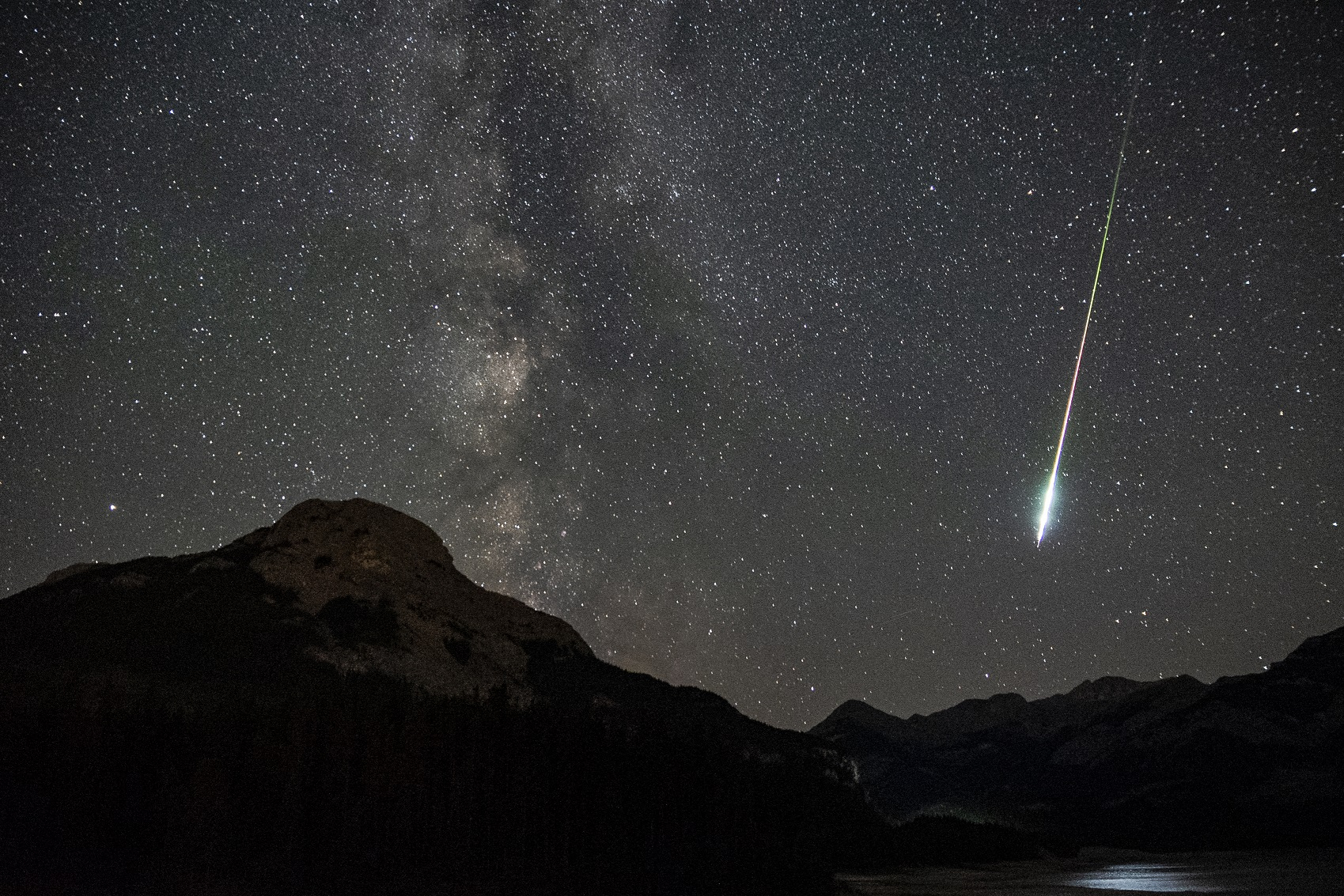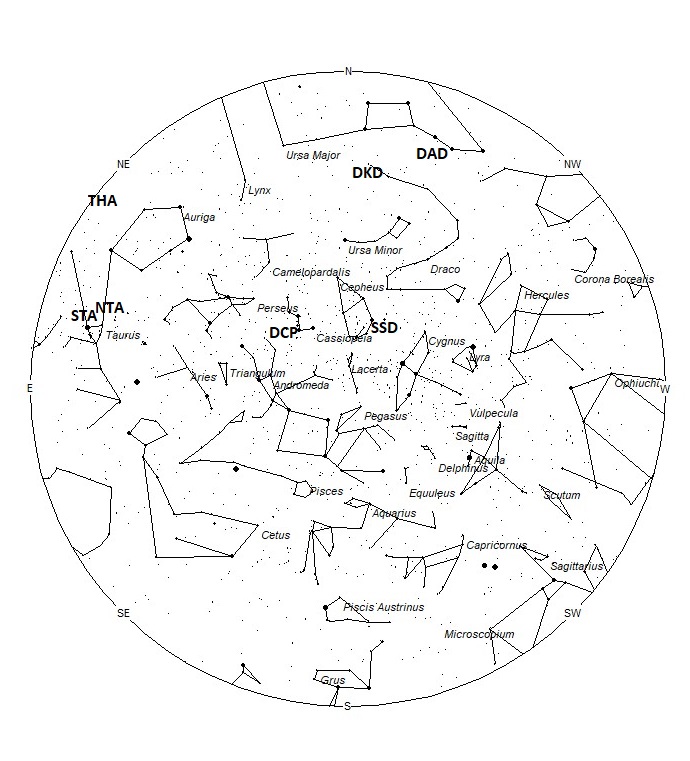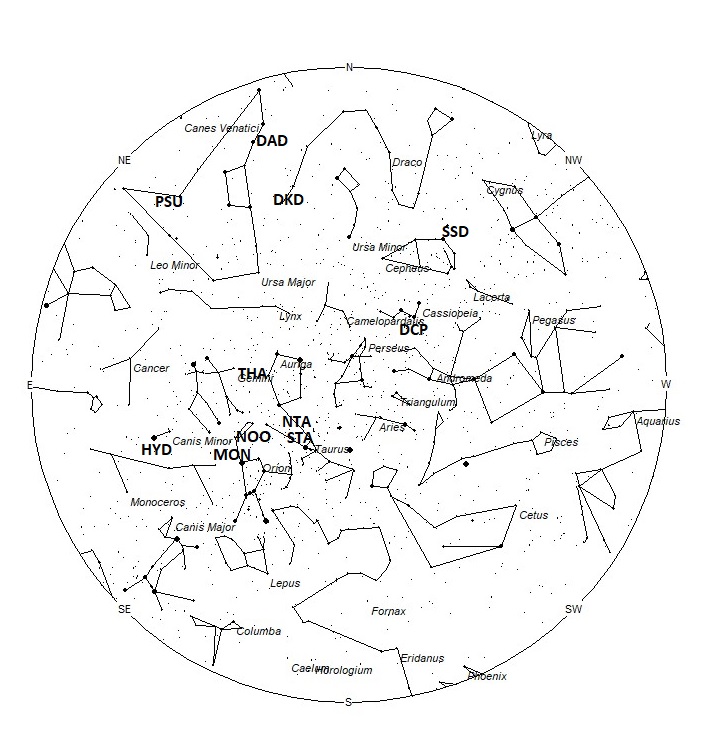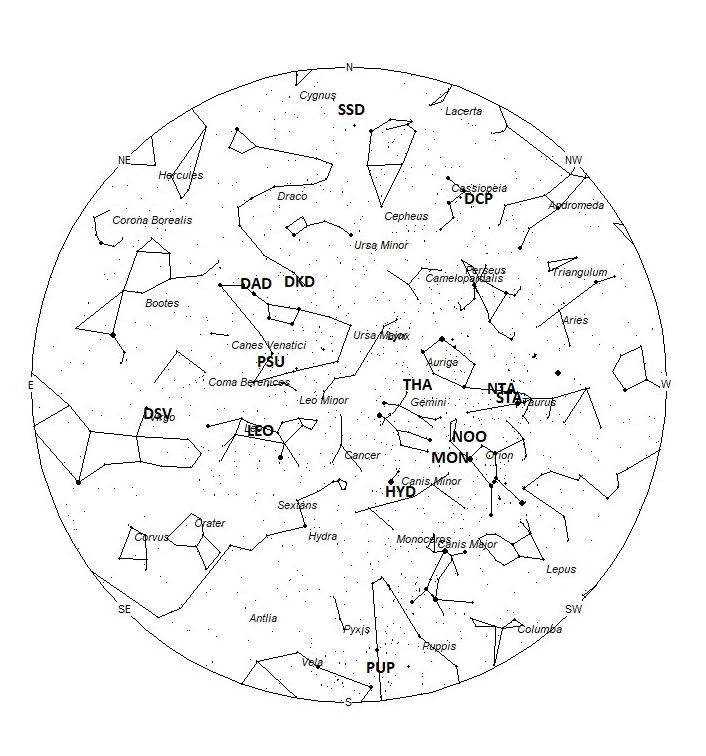 This outstanding fireball was captured by Christy Turner on August 13, 2020, at 06:41 UT from near Calgary, Alberta, Canada. Notice the fireball’s reflection off the water. Credit: Christy Turner
This outstanding fireball was captured by Christy Turner on August 13, 2020, at 06:41 UT from near Calgary, Alberta, Canada. Notice the fireball’s reflection off the water. Credit: Christy TurnerNo matter where you live, the first half of December provides some of the best meteor activity of the year. Unfortunately this year the bright moon will hamper the viewing of this activity during the first week of the month. In the northern hemisphere the sporadic rates are still strong plus you can also count on strong activity from the Geminids, which peak on December 14th. There are also several minor sources that add a few meteors each hour. All of these centers of activity are located high in the sky during the early morning hours this time of year. Much of the activity mentioned above can also be seen from the southern hemisphere. While the sporadic rates are not as strong as those seen from the north, they are stronger than the previous months and heading for a maximum in February. The warm, but short summer nights south of the equator make for some great viewing as long as the moon does not interfere.
During this period, the moon reaches its full phase on Monday November 30th. At this time, the moon is located opposite the sun and remains above the horizon all night long. This is the worst time of the month to try and view meteor activity as the bright moon will obscure all but the brightest meteors. The estimated total hourly meteor rates for evening observers this week is near 2 as seen from mid-northern latitudes and 1 as seen from tropical southern locations (25S). For morning observers, the estimated total hourly rates should be near 12 as seen from mid-northern latitudes (45N) and 7 as seen from tropical southern locations (25S). The actual rates will also depend on factors such as personal light and motion perception, local weather conditions, alertness, and experience in watching meteor activity. Rates are reduced during this period due to interfering moonlight. Note that the hourly rates listed below are estimates as viewed from dark sky sites away from urban light sources. Observers viewing from urban areas will see less activity as only the brighter meteors will be visible from such locations.
The radiant (the area of the sky where meteors appear to shoot from) positions and rates listed below are exact for Saturday night/Sunday morning November 28/29. These positions do not change greatly day to day so the listed coordinates may be used during this entire period. Most star atlases (available at science stores and planetariums) will provide maps with grid lines of the celestial coordinates so that you may find out exactly where these positions are located in the sky. A planisphere or computer planetarium program is also useful in showing the sky at any time of night on any date of the year. Activity from each radiant is best seen when it is positioned highest in the sky, either due north or south along the meridian, depending on your latitude. It must be remembered that meteor activity is rarely seen at the radiant position. Rather they shoot outwards from the radiant, so it is best to center your field of view so that the radiant lies at the edge and not the center. Viewing there will allow you to easily trace the path of each meteor back to the radiant (if it is a shower member) or in another direction if it is sporadic. Meteor activity is not seen from radiants that are located far below the horizon. The positions below are listed in a west to east manner in order of right ascension (celestial longitude). The positions listed first are located further west therefore are accessible earlier in the night while those listed further down the list rise later in the night.
These sources of meteoric activity are expected to be active this week.
.
Details of each source will return next week when viewing conditions are more favorable.
| SHOWER | DATE OF MAXIMUM ACTIVITY | CELESTIAL POSITION | ENTRY VELOCITY | CULMINATION | HOURLY RATE | CLASS |
| RA (RA in Deg.) DEC | Km/Sec | Local Standard Time | North-South | |||
| 66 Draconids (SSD) | Dec 04 | 20:56 (314) +60 | 18 | 16:00 | <1 – <1 | III |
| December Phoenicids (PHO) | Dec 05 | 00:50 (012) -52 | 12 | 20:00 | <1 – <1 | III |
| Dec. phi Cassiopeiids (DPC) | Dec 04 | 00:55 (014) +56 | 17 | 20:00 | <1 – <1 | III |
| Southern Taurids (NTA) | Nov 03 | 04:28 (067) +15 | 21 | 00:00 | 1 – <1 | II |
| Northern Taurids (NTA) | Nov 12 | 04:48 (072) +25 | 25 | 00:00 | 2 – 1 | II |
| November Orionids (NOO) | Nov 29 | 06:02 (091) +15 | 43 | 01:00 | 1 – <1 | II |
| Dec. Monocertids (MON) | Dec 13 | 06:12 (093) +10 | 43 | 01:00 | <1 – <1 | II |
| Nov. theta Aurigids (THA) | Nov 26 | 06:31 (098) +34 | 32 | 02:00 | <1 – <1 | IV |
| sigma Hydrids (HYD) | Dec 17 | 07:31 (117) +04 | 59 | 04:00 | <1 – <1 | II |
| Puppid/Velids (PUP) | Dec 07 | 07:52 (118) -45 | 40 | 04:00 | <1 – <1 | II |
| Leonids (LEO) | Nov 17 | 10:43 (161) +17 | 71 | 07:00 | 1 – <1 | I |
| psi Ursa Majorids (PSU) | Dec 05 | 10:52 (163) +47 | 60 | 07:00 | <1 – <1 | IV |
| Dec. kappa Draconids (DKD) | Dec 02 | 11:56 (179) +73 | 43 | 08:00 | <1 – <1 | IV |
| Dec. sigma Virginids (DSV) | Dec 19 | 12:32 (188) +10 | 66 | 08:00 | <1 – <1 | IV |
| Dec. alpha Draconids (DAD) | Dec 08 | 13:12 (198) +61 | 44 | 09:00 | <1 – <1 | IV |
 American Meteor Society
American Meteor Society



I saw a huge meteor over el cerrito CA at about 6:15 pm with long orange tail that had two small pieces broken off that appeared to be the size of stars going towards Napa CA
I saw a bright meteor at about 5:47pm U.S. Eastern time in the southern sky above Grand Haven MI along the Lake Michigan coast.
It was white-yellow with small amounts of orange and red. A fragment or two appeared to break off of it.
It was spectacular, and I am hoping to find video of it.
Just saw meteor in Buffalo, NY strength across sky, pretty cool
I’m on the southwest side of San Antonio. I was driving down my street around 12 am Dec 4,2020 facing towards Castrovile Tx? It was definitely on fire coming into our atmosphere. What a sight. It was burning blue and orange. I hope we hear something about it.